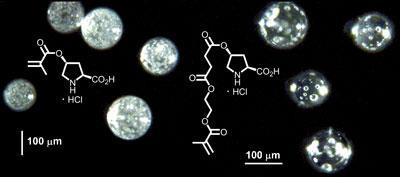A two-step approach to synthesising proline-containing beads for organocatalysis
Norwegian scientists have developed a new, more efficient approach to synthesising polymer beads containing proline and its derivatives, for use in organocatalysis. The technique could eventually be applied in large-scale industrial catalyst production.
As a chiral compound, the amino acid proline is a useful and versatile organocatalyst for asymmetric reactions - for obtaining enantiomerically pure (left- or right-handed) products, notably aldols, which are important in the chemical and pharmaceutical industries. It is well known that solid-supported prolines are more effective catalysts.
’Attaching catalysts to a polymer support is not a new concept, but the way we have done it is a little bit different,’ says Tore Hansen, who led the research at the University of Oslo in Norway. ’It’s more efficient but it’s also more readily scalable so you can actually use this is on a preparative scale to make large amounts of the catalyst.’
Hansen’s new approach uses acrylic chemistry as opposed to the traditional styrene chemistry that has been used for many years to synthesise polymer supports. As Hansen points out, water-hating styrene supports work best in non-polar organic solvents. But by using acrylic chemistry, polymers can be made to swell in very hydrophobic environments, as well as water, allowing reactive species to gain better access to reactive sites in the beads.

The use of acrylic chemistry in the context of proline-based organocatalysis is novel, according to Carmen Galan, an organic chemist at the University of Bristol in the UK. ’The methodology seems robust and one can envision it could be widely applied to other types of catalysts or molecules,’ she says.
The new synthetic approach involves just two steps. In the first, proline (meth)acrylates are synthesised from hydroxyproline. In the second, a copolymerisation reaction is used to complete the support, anchoring the catalyst to it during the process. The team are able to adjust the loading (the amount of catalyst required) by changing the ratios of the monomers used - a clear advantage over traditional methods, in which the final loading can be unpredictable, notes Galan.
’Polystyrene-based proline and proline derivatives are very interesting materials that can act as useful and recyclable organocatalysts,’ says Michelangelo Gruttadauria, an expert in supported catalysts for organocatalysis at the University of Palermo in Italy. ’Hansen has developed this alternative approach that can be further developed in order to obtain supported organocatalysts in a more convenient way.’
Hansen and his team have filed a patent for the technique and are already working on expanding its application to other types of catalyst.
Hayley Birch
References
Kristensen et alOrganic Letters, 2009. DOI: 10.1021/ol901134v






No comments yet